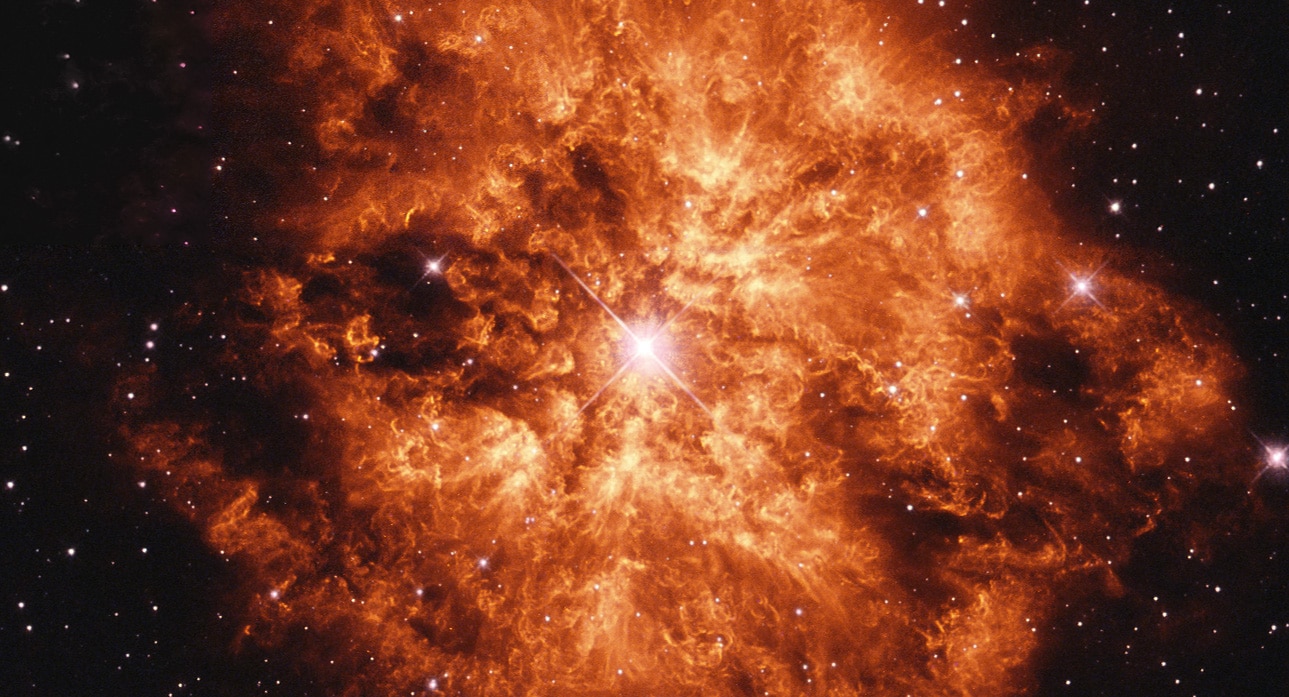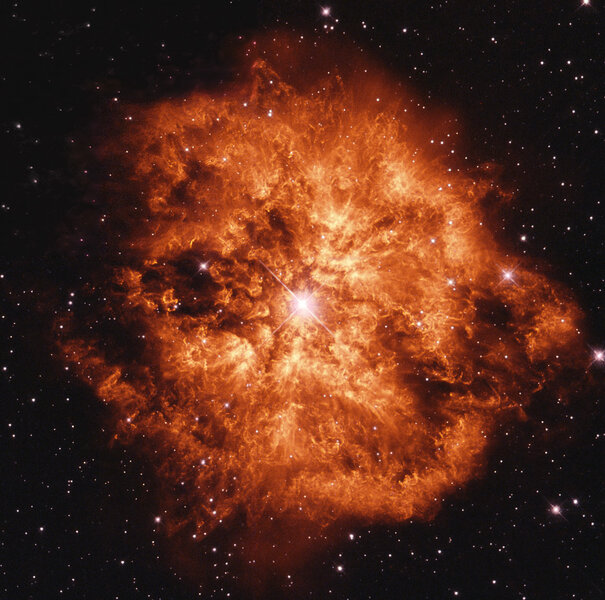Stellar hypoxia may help make more massive black holes
Lower oxygen in a star may explain two cosmic mysteries at once.

It seems like a bit of a non sequitur, but new research implies that if a star doesn’t make enough oxygen, it can become a massive black hole when it dies.
Yeah, that seems like an odd connection. But here’s how it works.
The issue centers around one of my favorite kinds of stars, called Wolf-Rayet stars. These are born massive, dozens of times the Sun’s mass, and live their lives furiously and quickly. Like the Sun they start off fusing hydrogen into helium in their cores, but their extra mass really squeezes the core, increasing the temperature and pressure. That means fusion goes on at a much higher rate than the Sun. The Sun has been fusing its core hydrogen for billions of years, but massive stars exhaust their supply in just a few million.
They then start fusing helium into carbon. As carbon builds up in the core, other reactions can take place, like fusing helium and carbon together to form oxygen — the two protons in the helium nucleus combine with the six in carbon to get a nucleus with eight: oxygen.
These stars produce so much energy in their cores that the outer layers of the star can start to blow off, lifted away by the fierce blast of light from below. This happens late in the star’s life, when it has only a couple of hundred thousand years left. The star becomes incredibly luminous, thousands of times brighter than the Sun, and the wind of gas blasted away is lit up by the beacon inside. It’s now a Wolf-Rayet star.
There are several kinds of Wolf-Rayet stars, depending on the chemical composition in their atmospheres. One is called a WC, which has lots of carbon in it, and another is WO, with lots of oxygen. It’s always been assumed that, since oxygen is created later in a star’s life, WO stars are more “evolved” than WC stars, closer to its inevitable end.
But the new study shows that’s not exactly the case [link to paper]. Looking at several WC and WO stars in the Large Magellanic Cloud, a companion satellite galaxy to our Milky Way, they found that it’s not that WO stars have more oxygen — in fact they have about the same amount as WC stars — it’s that WO stars are a lot hotter than WC stars. Oxygen glows better under those conditions, making it easier to see.
Ironically, though, their models of how stars behave show that WO stars are indeed farther along in their lives on average than WC stars anyway. Even weirder, WO stars have more carbon than WC stars! Along with that they seem to have less helium, and that got the astronomers thinking.
Models of how stars fuse nuclei together have a hard time getting the balance right with Wolf-Rayet stars. WO stars have more carbon and less oxygen than models predict. Why?
There are two main helium fusion reactions going on inside these stars. One was mentioned above which combines helium and carbon to get oxygen. Another fuses three helium nuclei together to make carbon. That first reaction lowers both the helium and carbon content in a star to make oxygen, but the latter makes more carbon. These reactions occur at rates that produce the amount of oxygen and carbon we see in the stars. To match the observations of WO stars, though, the models need to make more carbon and less oxygen.
One way to do that is if the first reaction — helium + carbon = oxygen — is slower than usually assumed. That reduces the amount of oxygen, and lets the other reaction make relatively more carbon. As it happens, the rate of helium/carbon fusion is not well understood, and could easily be 25 – 50% less rapid than first thought, enough to explain WO stars.
OK, great. Slowing the reaction rate solves that problem. But it turns out it may solve another.
When two black holes collide, they create gravitational waves, ripples in space-time. These can be detected, and the first were seen by the LIGO detectors in 2016. Over time dozens more have been found, and an odd situation arose: Black holes were seen that were too massive.
Black holes form when massive stars explode, and their cores collapse. This usually happens when oxygen fusion creates silicon, and then silicon fusion creates iron. Fusing iron actually removes energy from the core that it needs to support itself, so when iron starts to fuse the core collapses and forms a black hole.
But not always. Above a certain core mass complicated physics starts to take place, where the energy of oxygen fusion is so high that the gamma rays created in the fusion process convert into electrons and positrons: matter and anti-matter. The energy of the emitted gamma rays helps support the core, and if they go away by converting into matter/antimatter, the core can collapse long before iron fusion can start. This causes a titanic explosion, called a pair instability supernova (the “pair” refers to electrons and positrons). The star blows itself to shreds, and no black hole is made.
But we keep seeing black holes above that mass limit! How can that be?
Part of the problem in the core is if there’s a lot of oxygen available to fuse when the temperature gets high enough. This is what can cause the pair instability and detonate the star.
But, aha! If the reaction rate that makes the oxygen is slower than thought, not as much will be created, and the core becomes more stable at higher masses than the models originally predicted. These stars can then continue to exist instead of exploding when oxygen fusion commences. They can go through the normal stages of making silicon and then iron, then collapse into a black hole. This black hole can be more massive than the original models predict, explaining the higher mass black holes actually seen.
So a lower oxygen production rate explains both the WO Wolf-Rayet stars seen and the unexpectedly high-mass black holes detected by LIGO and its collaborators.
Scientists like it when a single assumption solves more than one problem. That makes it more likely to be correct. It’s not proof, but it does give it more weight.
Astronomers first conclusively showed stars powered themselves by thermonuclear fusion back in the 1950s. And here we are, decades later, still tweaking these monstrously complicated equations. That’s expected, and part of science: Better observations start to show cases where the equations don’t quite work, and need to be modified. And in this case we learn more about terrifying stars and beefy black holes. Win-win.






























